It seems we can’t find what you’re looking for. Perhaps searching can help.
Sign Up for newsletter!
Subscribe to get the latest eBook!
Hotline






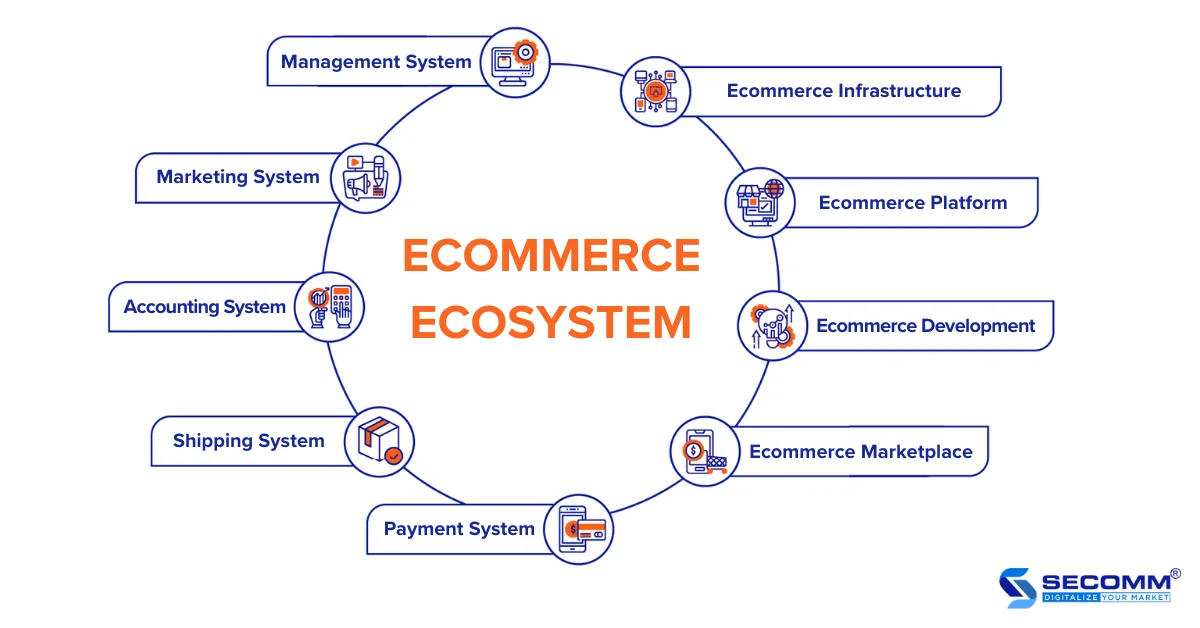
The ecommerce (Electronic Commerce) ecosystem is an open space that facilitates all interactions, connecting human factors, social elements, and information technology platforms with applications and services to provide value and efficiently operate components within the ecosystem. So, what are the components of the ecommerce ecosystem?

The system includes hardware (servers and devices), software (services/tools for management, and analysis), network systems, and physical facilities that form the foundation for the remaining components, ensuring smooth and efficient ecommerce processes.
Software applications are used to build and manage all activities within the system. Currently, businesses often use platforms such as Magento, Shopify, BigCommerce, WooCommerce, Haravan, and Wix to create ecommerce websites.
Provides services and solutions for developing websites, systems, and ecommerce processes. Some popular ecommerce solution providers in Vietnam include SECOMM, SmartOSC, Isobar, etc.
Provides an environment and all the services supporting ecommerce, allowing easy buying and selling between multiple sellers and buyers. Popular ecommerce marketplaces in Vietnam include Shopee, Lazada, Tiki, Sendo, etc.
Includes networks, systems, and devices processing all transactions within ecommerce. In addition to common payment methods such as cash, card payments (domestic cards, Visa, Mastercard, etc.), payment gateways (OnePay, PayPal, etc.), and e-wallets (Momo, ZaloPay, etc.) are developing in Vietnam.
The shipping system includes all processes for managing, distributing goods from warehouses, packaging, and delivering to customers. Popular shipping service providers in Vietnam include Giao Hàng Tiết Kiệm, Giao Hàng Nhanh, ViettelPost, J&T, Ahamove, etc.
Supports businesses in managing data related to invoices, sales revenue, and all financial flows in ecommerce activities. The emergence of e-invoicing software such as E-Invoice, MISA meInvoice, FPT.eInvoice, etc., has greatly supported accounting processes.
Marketing activities support effective brand and product development, reaching and personalizing customer experiences through strategies, channels, and supporting tools.
Uses resource management and operational process management software to enhance seamlessness and efficiency for the entire ecommerce system. Commonly used management systems include ERP, CRM, IMS, POS, OFM, etc.
In general, the components of the ecom ecosystem operate through a system of mechanisms, policies, and consistent laws to form a secure electronic data exchange system, ensuring the rights and responsibilities of businesses and consumers.
To achieve outstanding and sustainable growth, besides optimizing opportunities, businesses need to build a complete for themselves, creating a platform to enhance interactions between businesses, the market, and users more robustly. However, most Vietnamese businesses still face many challenges in building their ecommerce business plans. The majority of businesses have not correctly identified the necessary and appropriate components for their business models, leading to issues related to deployment time and budget constraints.
 2
2
 7,446
7,446
 0
0
 2
2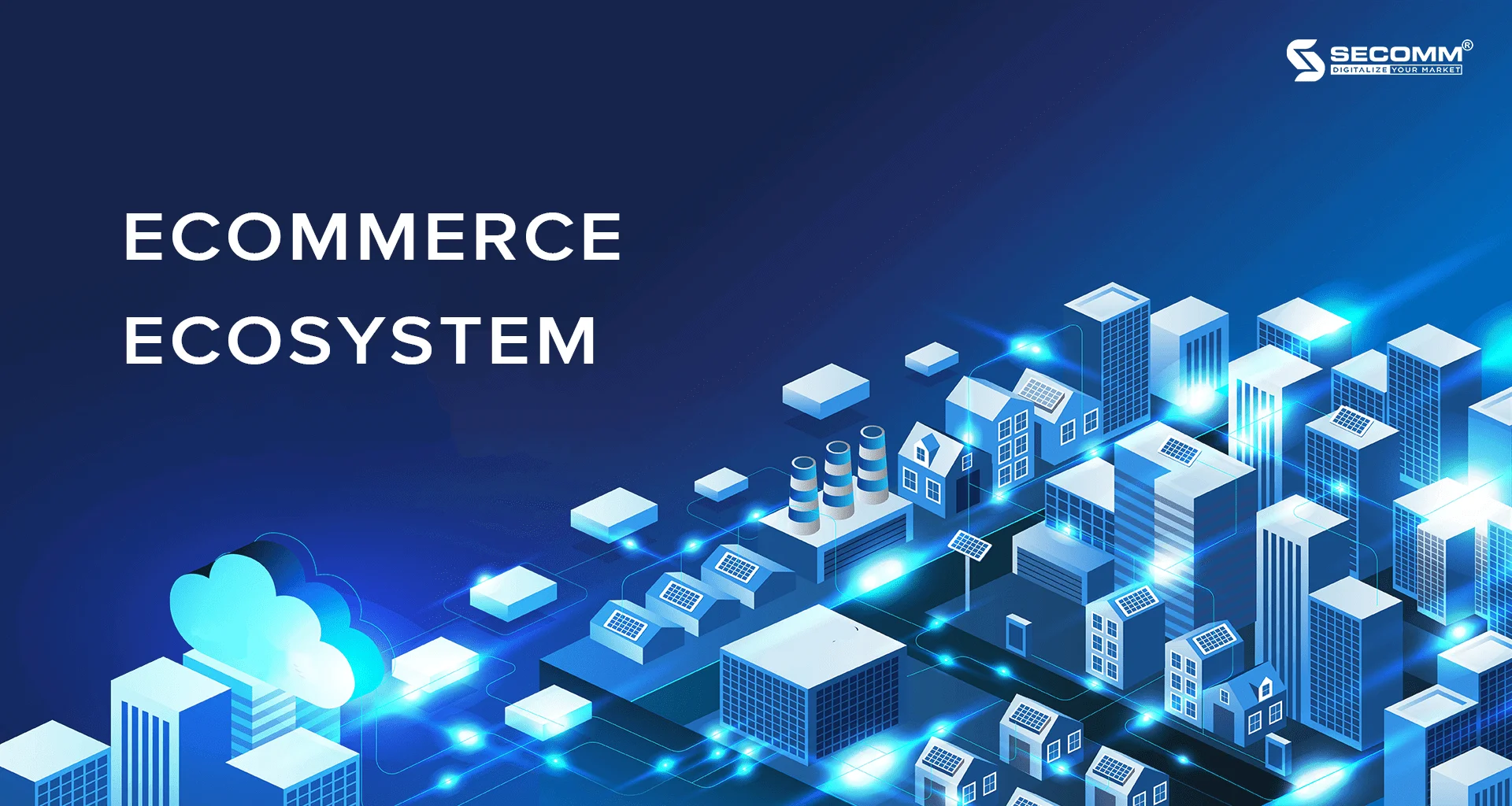
Vietnamese ecommerce businesses are welcoming transformational opportunities amidst the rapid development of technology, market, consumer, and major investor presence. However, for outstanding and sustainable growth, in addition to seizing opportunities, businesses need to build a comprehensive ecommerce ecosystem. Therefore, a best-finish of the ecosystem in general and its components, in particular, is the foundation stimulating businesses, markets, and user interactions.
So, what are the components of the ecosystem? How should the business develop the ecosystem in line with its business strategy?
The ecommerce ecosystem is an interconnected community implementing all interactions and connections of human organisms, social organisms, information technology and applications, and services to provide value and effectively operate the components in the ecosystem. (Based on the concept of Assoc. Prof. Dr. Nguyen Van Hong)
The ecosystem components are operated through consistent mechanisms, policies, and laws to create a secure data interchange system, ensuring the rights and duties of businesses and consumers.
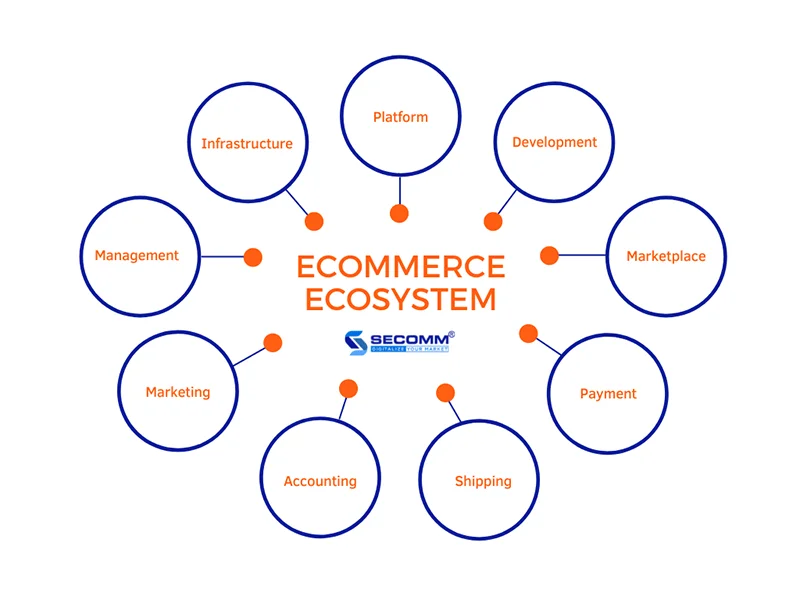
The main components:
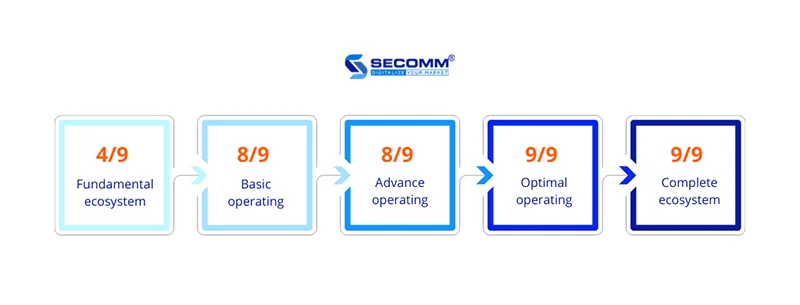
In the 1st stage, while customers are not been aware of their purchasing needs, the ecommerce ecosystem has fundamentally formed, beginning to approach, educate and stimulate consumers’ concern about brands and products.
Basic components (4/9): Infrastructure, Platform, Marketplace, Marketing
Highlight components: Marketplace, Marketing
Inchoate components: Development, Payment, Shipping, Accounting and Management
Customers become aware of their needs at this stage. As a result, the ecosystem comes into operation to approach potential customer needs.
Basic components (8/9): Infrastructure, Marketplace, Platform, Development, Marketing, Payment, Shipping, Accounting
Highlight components: Marketing, Payment, Shipping, Accounting
Inchoate components: Management
The ecosystem enhances operation with many essential functions to directly navigate customers’ searching and buying considerations, thereby increasing the customer funnel conversion.
Advanced components (8/9): Infrastructure, Development, Marketplace, Platform, Payment, Shipping, Accounting, Marketing
Maintaining components: Infrastructure, Development, Marketplace, Accounting
Highlight components: Platform, Payment, Shipping, Marketing
Inchoate components: Management
When customers transition to the decision-making stage of purchasing, the ecosystem maximizes effectiveness in all processes and operational components, simultaneously focusing on developing conversion functions through continuous improvement and innovation of marketing components.
Optimal components (9/9): Infrastructure, Development, Marketplace, Platform, Payment, Shipping, Accounting, Marketing, Management
Maintaining components: Infrastructure, Development, Marketplace, Platform, Payment, Shipping, Accounting
Highlight components: Marketing, Management
All the ecosystem components are complete and effectively interact with each other. In addition, the ecosystem is directed towards operating maintenance to support product experience, customer retention, and return-customer stimulation.
Optimal components (9/9): Infrastructure, Development, Marketplace, Platform, Payment, Shipping, Accounting, Marketing, Management
Maintaining components: Infrastructure, Marketplace, Payment, Shipping, Accounting, Marketing
Highlight components: Platform, Development, Management
Although the ecommerce ecosystem in Vietnam is proliferating, it is being hampered by substantial barriers.
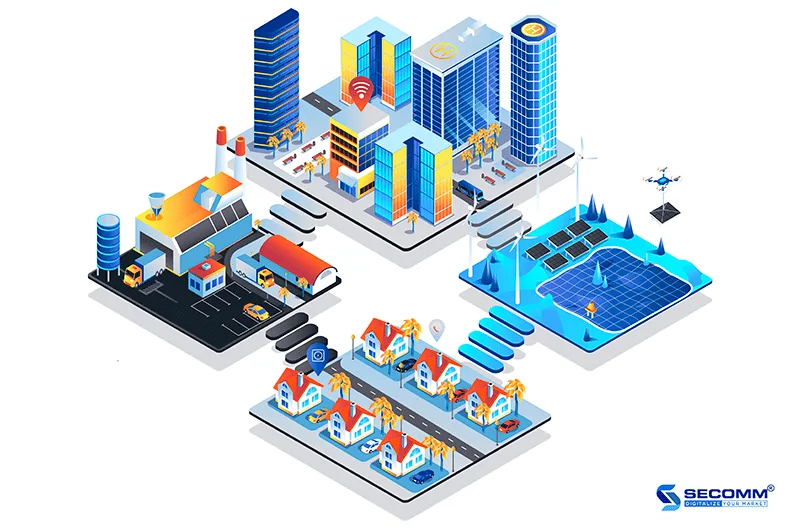
In comparison to the general Vietnam market, ecommerce would be a relatively new business. As a result, the legal framework for ecommerce remains inadequate and disorganised. In which tax, security, and information authentication in e-transactions, intellectual property rights, etc., have not been adequately safeguarded by legal means.
The disparity between the legal framework’s perfection and the faster market change makes ecommerce challenging to control or at threat of unhealthy growth.
Circular No.47/2014/TT-BCT on the management of ecommerce websites, particularly, contains guidelines on the ecommerce business registration process and procedures. However, their controlling method has not been carried out properly, resulting in fewer registered businesses than actual statistics.
Therefore, most of the legalities of starting ecommerce business have not been verified, leading to transaction fraud and other fraud. More serious are domain misappropriation and spoofing by hackers to business counterfeiting, causing severe damage to businesses and consumers.
This shows that the current legal framework needs to enforce more specific steps to prevent attacks from cybercrime.
One of the significant barriers is the reality that occurs throughout the purchase process. For example, product and service quality issues, typically the quality assurance process (for counterfeits, poor quality products), transaction frauds (credit account takeover), and shipping (fraudulent goods exchange in packaging and shipping),… all have a direct impact on customer interests and the healthy, sustainable growth of the ecommerce ecosystem.
Another significant barrier is the competition and investment budgets among businesses. In particular, data security requirements and infrastructure investments are putting financial pressure on existing ecommerce businesses. As a result, the ecommerce ecosystem is primarily controlled by the expansion of marketplaces and international businesses investing in the Vietnam market.
Although the current number of ecommerce ecosystem components is fully completed, the uneven development level makes interactions and operational processes sporadic and challenging to achieve optimal growth. The challenges have mainly come from:
Besides, the most significant barrier is the lack of a strong connection among ecosystem components to bring unifying and synchronous ecommerce solutions. The current connections are commonly between marketplaces and shipping providers or digital banking/e-wallets to provide economical and intriguing solutions for consumers.
However, that seamless and unified connectivity has not yet evolved to maximize business interactions in the ecosystem and among businesses in the ecommerce market.
The ecommerce ecosystem completion is a sustainable foundation for SMEs to build and implement ecommerce business plans aligned with each business stage while generating a complete ecosystem for themselves.
About the number of components
Businesses should determine the suitable components according to each business model and growth stage.
For example, a small and medium-sized enterprise would use the essential ecommerce components, such as the platform, to develop a complete ecommerce system, complete payment, shipping, and integration processes integrating more management software, namely CRM, POS, accounting, and marketing tools.
Nevertheless, a medium/large-sized enterprise can integrate ERP for resource operation or omnichannel for efficient expansion.
About timeline
Following the identified ecosystem components, a business can estimate the appropriate timeline to promote in-time business processes, fully satisfying the market requirements and customer needs. Thereby, the satisfaction enhances the planning efficiency and the ecommerce ecosystem.
About the implementing budget
The budget would be distributed more specifically once the essential ecosystem components are clearly defined for your business model. Determining the proper budget is a critical factor for SMEs to successfully implement ecommerce and sustainably grow. This is especially important for existing SMEs due to the considerable budget pressures and the long-term investment process.
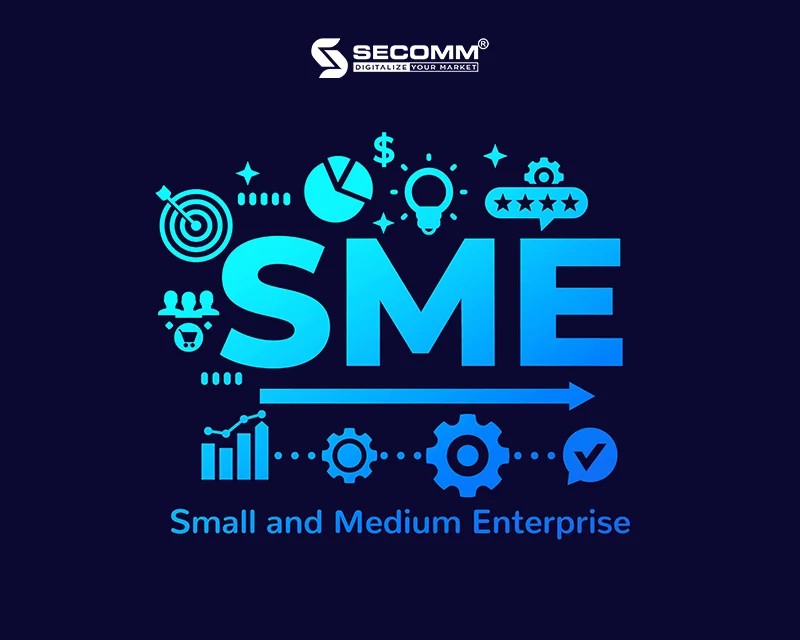
However, most of those SMEs still face many challenges in building their ecommerce plans. They have not adequately defined their business model’s needed and best-suited components, resulting in timeline and budget dilemmas.
With in-depth experience providing full-service ecommerce solutions, SECOMM will accompany businesses in respective stages of ecommerce implementation with tailor-made solutions.
Contact SECOMM to receive a comprehensive ecommerce consulting solution for your businesses.
 2
2
 7,959
7,959
 0
0
 2
2Subscribe to get the latest eBook!
Hotline